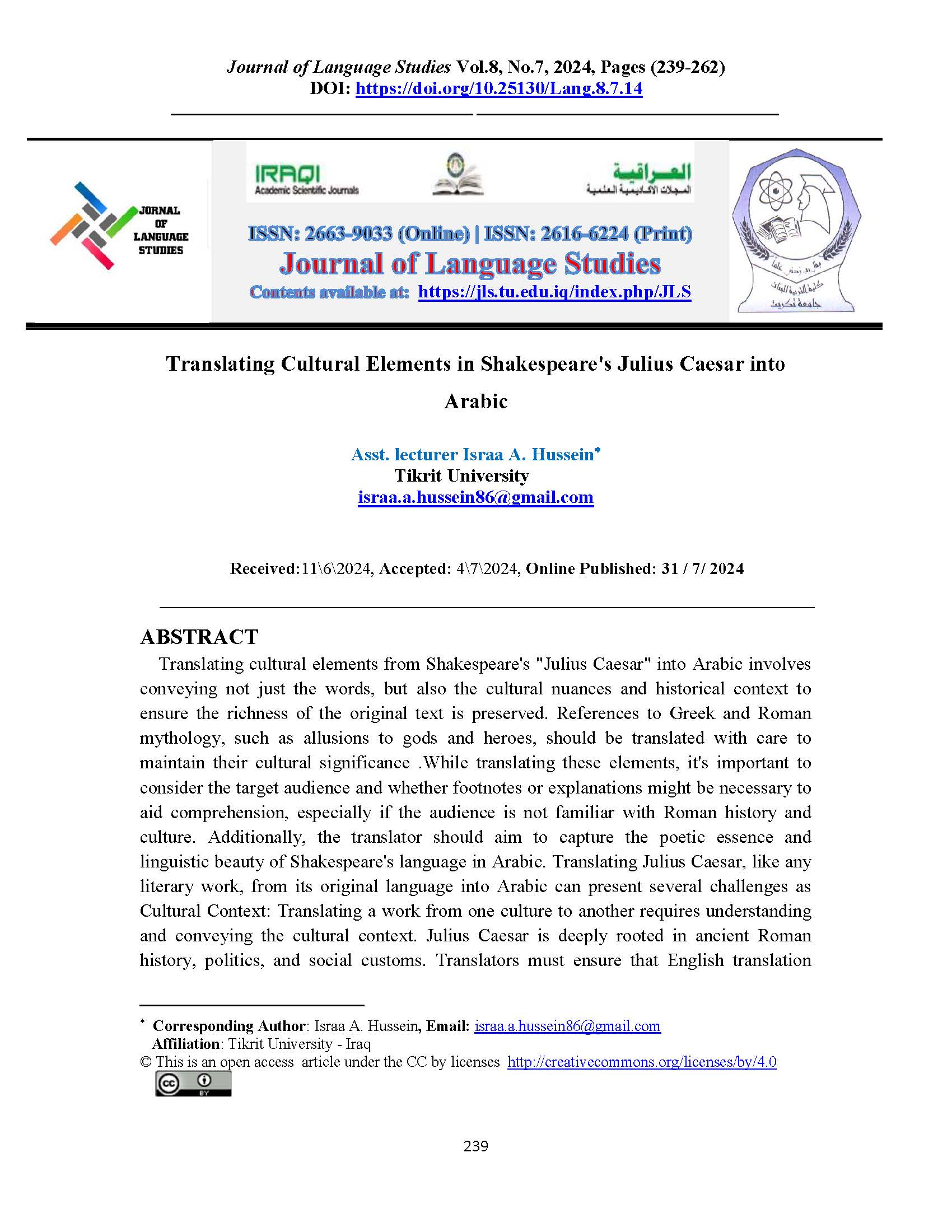Translating Cultural Elements in Shakespeare's Julius Caesar into Arabic
Israa A. Hussein
Tikrit University
DOI: https://doi.org/10.25130/Lang.8.7.14
Keywords: Culture, Cultural Translation, Shakespeare studies, Translation
Abstract
Translating cultural elements from Shakespeare's "Julius Caesar" into Arabic involves conveying not just the words, but also the cultural nuances and historical context to ensure the richness of the original text is preserved. References to Greek and Roman mythology, such as allusions to gods and heroes, should be translated with care to maintain their cultural significance. While translating these elements, it's important to consider the target audience and whether footnotes or explanations might be necessary to aid comprehension, especially if the audience is not familiar with Roman history and culture. Additionally, the translator should aim to capture the poetic essence and linguistic beauty of Shakespeare's language in Arabic. Translating Julius Caesar, like any literary work, from its original language into Arabic can present several challenges as Cultural Context: Translating a work from one culture to another requires understanding and conveying the cultural context. Julius Caesar is deeply rooted in ancient Roman history, politics, and social customs. Translators must ensure that English translation conveys the cultural nuances and historical background accurately to make the play accessible and meaningful to English-speaking readers or audiences. Translating Julius Caesar into Arabic demands a deep understanding of the play, the cultural context, and linguistic intricacies. Translators must navigate the challenges of language structure, cultural adaptation, and poetic form to create a faithful and resonant Arabic version of the play.
References
• Aixela, J. F., 1997. Culture-Specific Items in Translation. Translation, Power, Subversion, Alvarez, R. and Carmen-Africa Vidal, M (eds.). Clevedon: Multilingual Matters
• Armellino, E (2008). "Translation culture-bound elements in subtitling: An example of interlingustic analysis", Translation Journal.
• Asad, T. (1995). A comment on translation, critique & subversion. In A. Dingwaney& C.Maier (eds), between language and culture. Pittsburgh: university of Pittsburgh press.
• Bassnett, S., & Lefevere, A., 1998. Constructing Cultures: Essays on Literary Translation. Clevedon: Multilingual Matters.
• Bassnett, S., 2011. Reflections on Translation. Bristol: Multilingual Matters.
• Davies, E. E., 2003. A Goblin or a Dirty Nose? The Treatment of Culture-specific References in Translations of Harry Potter. The Translator 6.
• Faiq, S. (2004). Cultural Encounters in Translation from Arabic. Multilingual Matters Ltd.
• Hofstede, G. H., Hofstede, G. J., & Minkov, M., 2010. Cultures and Organizations: Software of the Mind: Intercultural Cooperation and its Importance for Survival. New York: McGraw-Hill.
• Jiang, W., 2000. The Relationship between Culture and Language. ELT J (2000) 54 (4).
• Larson, M. L.,1984. Meaning-Based Translation: A Guide to Cross-Language Equivalence. Lanham: University Press of America.
• Newmark,P. (1988). A textbook of translation. New York: Prentice Hall.
--------- (2001). " Translation and culture". In T. Marcel & Lewandowsked (eds.) Translation & meaning: parts 5.Poland.
• Nida, E., 1964. Principles of Correspondence. The Translation Studies Reader. Venuti, L.(ed.), 2000
• Sara, S. (2004). Translating native Arabic linguistic terminology. In S. Faiq (ed.), Cultural encounters in translation from Arabic. Clevedon: Multilingual Matters.
• Shunnaq, A. (1997). Issues in translation: Problems in translating Arabic texts into English . Irbid: Irbid National University & Jordanian Translators' Association.
• Toury, G. (1980). In Search of a Theory of Translation. Tel Aviv: The Porter Institute for Poetics and Semiotics, Tel Aviv University.
• Venuti, L. (1996). Translation as social practice: Or, the violence of translation. In M. Rose (ed.), Translation horizons beyond the boundaries of translation spectrum [translation perspectives ix]. Binghamton: State University of New York.
• Wafaa, D Mohammed, 2019. "A Cultural Based Pragmatic Approach for Analysing English- Arabic Dramatic Cultural Refrences with refrence to Translation". Journal of Language Studies .
• Zare-Behtashe, E. & Firoozkohi, S., 2010. Culture-Specific Items in Literary Translations.
• Zhang, B., 2013. Innovative Thinking in Translation Studies: The Paradigm of Bassnett’s and Lefevere’s “Cultural Turn”. Theory and Practice in Language Studies, vol. 3, no. 10
• Zughoul, M & Hussein, A (2003). "Translational Collocational Strategies of Arab Learners of English: A study in lexical semantics", Babel international journal of translation, vol. 49(1).

